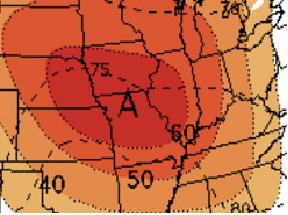Woe Of The Corn: America's No. 1 Crop Threatened By Drought
FORT WORTH (CBSDFW.COM) – America is the world's largest corn producer, growing a staggering 40 percent of the world's supply. It is also No. 1 cash crop in the United States, taking in about $76 billion last year.
As goes corn so goes many products and prices; take Texas beef, for example. Raised on pasture grass, the steers and heifers are shipped to feedlots to gain the extra 300 to 400 pounds of profit from eating corn.
In fact, United States Department of Agriculture (USDA) figures show 80 percent of American corn goes to livestock feed. It goes to beef, poultry, pork and fish not only in the United States but around the world, especially in China.
When the price of corn goes up so does the price of meat. The market show this; the largest producers of chicken (Tyson) saw it's stock price go down over the last two weeks (more expensive corn means less profit).
Another product of corn is the 10 percent of ethanol in your gas tank. One 56 pound bushel of corn produces about 2.8 gallons of the fuel additive, the USDA says. The corn's protein is left behind in the process and still goes to livestock feed. About 40 percent of the U.S. crop is diverted to ethanol production and the fuel additive is currently trading at an eight month high.
Meanwhile corn is trading at an all-time high now that it appears there is going to be much less of it this year.
The corn crop in America is currently in the middle of a potential drought catastrophe. Below, look at last week's drought update. I've drawn in blue what is considered the heart of the Corn Belt where 50 percent of the crop is grown. You can see that every bit of it is under some kind of drought stress:
The latest drought update is coming out Thursday and many of those in the commodity business have already hedged their bets that things are getting worse.
Here is a quote from this Bloomberg News article:
- "The drought of 2012 will be one for the records," said Peter Meyer, the senior director for agricultural commodities at PIRA Energy Group in New York, who forecasts a drop in output to 11 billion bushels if the hot, dry spell lasts another three weeks.
And it looks like the drought will continue for at least three weeks. Triple digit highs are again forecast today for large swaths of the corn growing region. The six to 10 day outlook puts the odds of higher than normal daytime highs dead center over the region:
This matches up well with the outlook for the month issued by the Climate Prediction Center at the end of June:
The price of a bushel of corn is currently $7.50, significantly higher than the $5 that was forecast at the start of the growing season. The reason for the $5 forecast was that American farmers planted 96.4 million acres of corn –– equivalent to about two-and-a-half Iowas, if you could plant every square foot of the state –– the highest since 1937.
The USDA forecast at the start of the year this years' crop to reach a record 14.7 billion bushels. But 60% of the corn-producing lands (including the highest yielding plots) are in some kind of drought stress.
Count on higher gas and food prices because of it. This makes the third year in a row that the U.S. corn crop has come in under forecast, something that is almost unprecedented in the modern farming era of better genetics and equipment.
Last year it was flooding (ironically) in a large part of the corn belt combined with the drought in the southern plains, including, of course, the historical drought in Texas despite the fact that the state is a very small corn-producer. Back in 2010 the problem was, again, flooding in the Midwest.
This year they pray for rain, and that it arrives soon.






